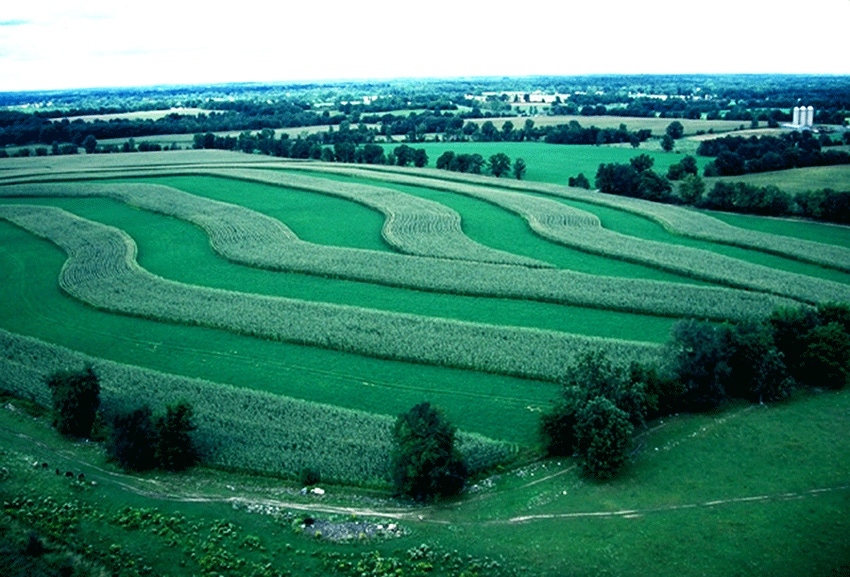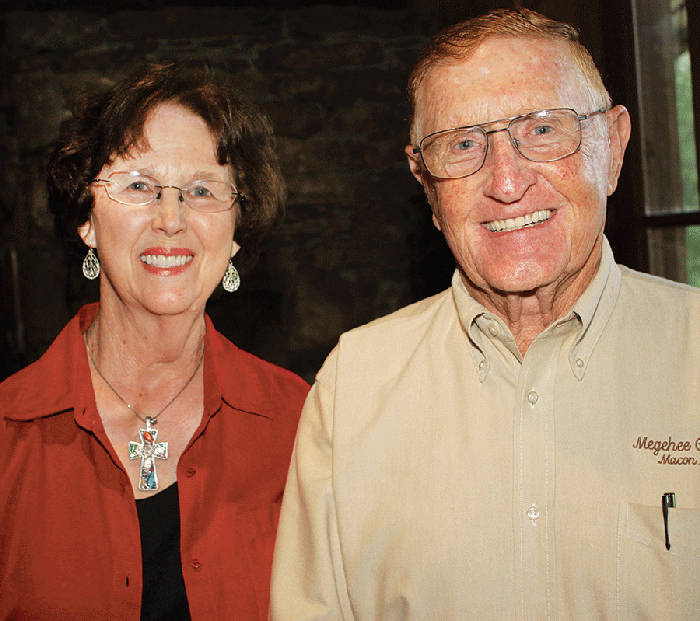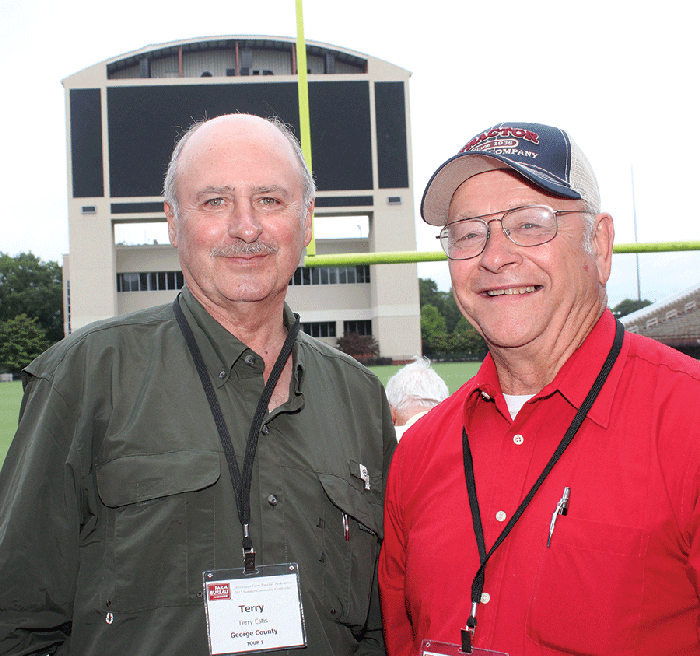
As attempts proliferate to get the government — and federal supports — out of agriculture, there is a greater need for the private sector to step up and help to fill the void, particularly in areas of conservation and sustainability, says Jason Weller.
He’s seen firsthand how the sharp shrinkage of one branch of government has impacted American agriculture. During his four years as chief of the USDA’s Natural Resources Conservation Service he saw the agency’s employee numbers drop from 12,000 in 2012 to fewer than 10,000.
Macon, Miss., cattle producers Jake and Martha Megehee were among those attending the Mississippi Farm Bureau Federation Summer Commodity Conference..
“We lost 2,000 men and women with boots on the ground, providing service to America’s farmers and ranchers,” he said at the Mississippi Farm Bureau Federation’s Summer Commodity Conference at Mississippi State University. “The people who are left have a hard job; there are a lot of vacancies in NRCS offices; they’re spread thin, they’re stressed. They can’t provide the level of services they’d like to because they don’t have the capacity they need to help you try and keep your farms in production, help you make your payments, send your kids to college, and pass on your farm or ranch to your children and grandchildren.
His eight years total with NRCS, and prior to that work with the House Appropriations Subcommittee on Agriculture, the House Budget Committee, and the White House Office of Management and Budget, gave him unique insight into the development and implementation of the USDA’s conservation programs, he says.
“But I also saw the limitations of the public sector. Right now is a challenging time for agriculture and conservation programs — a lot of resources at the public level have become pretty thin.”
This led, Weller says, to his “looking into what the private sector can do: What is theopportunity to help agriculture have a voice, to advocate for itself, to demonstrate its leadership, but at the same time have private agribusiness industry working alongside the public sector to provide solutions for growers?”
CHANGING CONVERSATION ABOUT SUSTAINABILITY
That search led him to the giant Land O’Lakes cooperative and his present role as senior director of sustainability for the company’s 2016 startup, Land O’Lakes Sustain, “a business unit of about 15 people, created to work alongside the big dogs of agriculture, to think about how we can change the conversation about agricultural sustainability, and start driving solutions through our ag retail dealers and dairy membership.”
Terry Estis, left, Lucedale, Miss., and Roger Jefcoat, Laurel, Miss., were checking out the Mississippi State University football stadium during a tour of the campus.
Land O’Lakes, which started as a co-op of 300 dairy farmers in 1920 at Minneapolis, is today, 96 years later, in all 50 states, and is a Fortune 200 company that employs over 10,000 people, with revenues of $14 billion to $15 billion annually.
“As I travel, everyone tells me, ‘I love your butter,’” Weller says. “But we’re a lot more than butter. Through Winfield United, we’re into leading edge technology for farm production. Our Purina division is about a lot more than dog chow, predominantly providing cutting edge nutrition for livestock operations across the U.S., but also zoo feeds from alligators to zebras and everything in between. Land O’Lakes Dairy Foods provides a range of ingredients to the food industry, from the cheese dust on Cheetos, to ingredients for Kraft, Nestle, Hershey, and many other major companies.
“We’re owned nationally by 2,200 dairy members, 1,300 row crop producers, and 800 ag retailers. Through that network, we touch 50 percent of harvested acres in the U.S. in some form or fashion — that’s 100 million acres of row crops. One-fourth of all American farmers are touched through the Land O’Lakes enterprise network, and 30 percent of all protein consumed in America goes through Land O’Lakes enterprises.”
OPPORTUNITY TO ADVOCATE
It is through that extensive network of retailers and owners, Weller says, “that we have an enormous opportunity, not just to advocate, but to invest and bring about solutions. Land O’Lakes is really unique in that it’s one of the few companies that has the insight and ability to work with U.S. agriculture from planting to harvesting all the way through until the product ends up on the dinner table.
“And because we’re farmer owned, we aren’t just responsible to the consumer — more importantly, we’re responsible to the grower. Every day our employees wake up and think how they can bring value to their owners, the farmers: How do we advocate more effectively for growers; how do we bring common sense to the industry?”
With 10 billion people expected on the planet by 2050, Weller says, “In the next 40 years you’re going to have to produce as much food and fiber, as many calories, as was produced in the last 500 years. How to do that without denuding our soils; impacting rivers, estuaries, and lakes; and stripping out our wildlife areas and forests is an enormous challenge.
“There’s a global gold rush going on right now, except it’s not the metal gold that international investors are pursuing — it’s land and water. Israel, China, Saudi Arabia, United Arab Emirates, Egypt, they’re buying up land in Africa and South America. They’re worried about feeding their own people, about access to soil and water.
“In the U.S., we’re blessed with water and some of the most productive soils in the world. It’s our competitive advantage against other nations and other producers. It represents a responsibility, but also an enormous opportunity.”
This will necessitate, Weller says, “equipping the American farmer with the technology, tools, and know-how to produce not just today’s crops, but tomorrow’s crops, and to be sustainable so they can be economically successful 10, 20, and 40 years from now.”
MODERN FACE OF AGRICULTURE
These are the kinds of investment Land O’Lakes wants to make alongside growers,” he says. “Because we’re farmer owned, we want to advocate, with our retail owners and the farmer network we work with at the state and national level, to present the modern face of agriculture — its sustainability, stewardship, leadership, innovation, capabilities, and good neighborliness, things you’re doing on a daily basis to protect your soils, water, forests, in your own communities, and how you’re being a really good neighbor to those in the cities.
“It’s something we’re really passionate about,” Weller says, “and we’re trying to develop resources to change the conversation. In Land O’Lakes Sustain, with three main pillars of air, soil, and water, we’re identifying the right practices, technologies, and products so we can help growers address the conditions and quality of these resources.

“In the next 40 years, farmers are going to have to produce as much food and fiber, as many calories, as was produced in the last 500 years. How to do that without denuding our soils; impacting rivers, estuaries, and lakes; and stripping out our wildlife areas and forests is an enormous challenge.—Jason Weller, Land O'Lakes Sustain
“Whether it’s a dairy producer in Minnesota, a row crop producer in the South, or a citrus grower in California’s central valley, with the enormous environmental regulations they face every day, we need to determine how we can help them put in place the right conservation practices to improve the quality and health of their soils so they will be more productive, more resilient, have better water-holding capacity and filtration, better withstand dry and wet periods, and optimize fertilizer and inputs — not just to maximize production, but to protect soils and downstream water quality.”
At present, Weller says, the strategy is to ”work through our retail network.” He cites a recent survey of producers, asking whom they most trust when seeking recommendations on farming practices. “In the No. 1 spot were ag retailers and chemical dealers. Seed dealers were No. 2; other farmers No. 3; and soil/water conservation districts, NRCS, and Extension were No. 4.
UTILIZING TRUSTED RETAIL NETWORK
“It’s about using that powerful, trusted retail network, and equipping it with extra tools and know-how to work better together, to give farmers answers on seeding rates, fertilizer, the best practices to protect soil and water. It’s about having an integrated network, starting through the retail owners.”
About 25 retailers are presently members of Land O’Lakes Sustain, Weller says, “and this summer we’ll be signing up another 10 or so. They are predominantly in the corn belt, but over the next several years our goal is to massively expand that network across the U.S., working through retail owners to deliver on-farm conservation solutions.
“We’re also working with Consumer Packaged Goods (CPG) companies, and retailers like Walmart, Smithfield Foods, Kellogg’s, etc. Because we’re a farmer-owned co-op, we’re able to get into corporate boardrooms, bring a farmer voice into the conservations and design common sense programs of sustainability services for these companies. We’re turning the conversation around to work to the benefit of the farmer, rather than the farmer being the last to be considered in what goes on the retail shelf.”
This centers on “basic common sense, tried-and-true core practices and technologies that you’re using today,” Weller says. “The practices may include grassed waterways, terraces, precision ag technologies, etc. — all in a comprehensive package that growers can use on their farms. It’s not a cookie cutter recipe; it starts with what the grower wants in his or her operation, and helps them, over time, to incorporate those practices into their farming operations, not only for their economic success, but for broader environmental success.
“It’s using technology and tools to help farmers have insight into what’s happening in their fields. Then we can have conversations with them about how to boost production where they’re having under-performance, what’s going on that they’re not getting yield, are they over-applying inputs, what to do to optimize and minimize loss.”
Beyond production insights, Weller says, “We have technology to provide similar insights on soil erosion. A tool, Soil Calculator, helps show loss of soils. We can do scenario-building, perhaps with rotational no-till, or other practices that can cut soil loss as much as 80 percent.
TOOLS TO PUT FARMERS IN CONTROL
“Putting this insight and comprehensive tool chest into grower hands will put them in control so they will have the capacity and insight not just to manage crop production, but also to manage soils for the long term increased production we will need for the future. It’s about tools to put farmers in control.”
Conservation experts are being hired, he says, to provide training and technical support for ag retailers to help figure out the right practices for a producer, or to equip the retailer to be able to have informed conversations with USDA, or state departments of agriculture, or about what financial assistance is available to the grower, so the retailer can have a conversation with the grower, rather than the confusion from a lot of people being involved.
“I worked and lived in Washington, D.C., the last 16 years, Weller says, “and I can tell you, it’s crucial that agriculture have a profound, powerful voice. Mississippi has one of the most effective, most powerful agriculture voices in the country. Right now, agriculture needs common sense solutions for the farmer, not just here in Mississippi, but nationally, about the types of practices that can result in a sustainable agriculture.
“The congress and the administration need to hear from you. I guarantee you that today, next week, next month, there are groups in Washington that have viewpoints about USDA’s conservation programs, crop support programs, risk protection programs, and their their messages are not to your benefit.
“You must make your voice heard. D.C. decision-makers need to hear from you, to know what works and also what gets in your way. Land O’Lakes wants to co-invest with you, to be alongside you, to be a part of that voice, providing common sense solutions — not just at the state or national level, but down on the farm.”
About the Author(s)
You May Also Like




